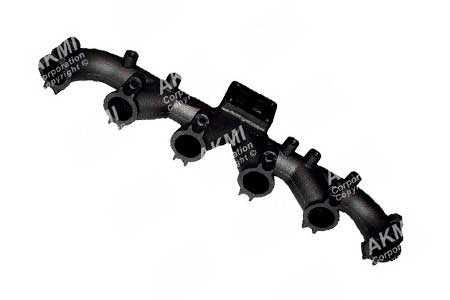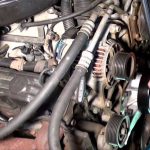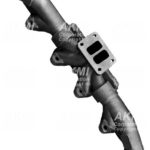
Marine exhaust systems are an important part of marine engines, but are often overlooked. When it comes to the exhaust systems, there are two main options for recreational boats: Wet or Dry.
Ever wonder why a marine exhaust manifold looks like a big square piece of metal versus an automotive exhaust manifold with its tubes more prominent. The main reason is to accommodate the flow of water mixing in with the exhaust fumes, this type of manifold would apply to a “Wet” exhaust system.
All Wet
A wet exhaust mixes seawater with the exhaust before it can be routed out of the boat. Injecting seawater into the exhaust can dramatically lower the temperature of exhaust run, which reduces risks of fire or being burned by an exhaust pipe.
The water is provided by a dedicated seawater pump which in turn routes water through the engine lube oil cooler, gearbox cooler and main heat exchanger prior to being injected into the exhaust downstream of the exhaust manifold itself.
Bone Dry
This is a dry exhaust system (no seawater is present) and produces high temperatures. Diesel exhaust gases can reach as high as 1200 degrees F. This means that special “lagging” or insulation needs to be added to surrounding areas or parts, to protect surrounding equipment, boat structure and people.
Since no water is used in the exhaust, there are different options in regards to engine cooling. A heat exchanger can be used and seawater would simply be discharged overboard. Another common alternative would be moving the entire heat exchanger outside of the boat. The passing water would carry away the heat, much like a radiator does for a car.
While wet exhaust systems are much more common for recreational boats in general, many builders of deep-sea passage makers prefer to use dry exhaust systems on a number of their models.
Wet Exhaust – Pros & Cons:
- PRO – Far fewer heat issues with exhaust runs.
- CON – Seawater pump failure could destroy the engine.
- PRO – More Interior Space
- CON – Extra maintenance for the sea strainer, pump and injector elbow
- PRO – Easier to design and install
- CON – Exhaust can blow into boat in following wind.
Wet exhaust systems also require a hole in the boat for the intake which requires extra sealing. If the pump fails or strainer is clogged, engine temperature would begin to rise and set off alarms. You may only have a few seconds to shut down your engine before major damage is done.
There is also the potential of flooding the engine when over cranking at engine start-up. Too many unsuccessful starting attempts could dump enough water into the exhaust flooding the turbocharger, exhaust manifold, cylinders and cause catastrophic damage to an engine.
Dry Exhaust – Pros & Cons:
- PRO – No seawater pump to maintain, or have fail
- CON – Dangerous heat levels
- PRO – No seawater strainer to maintain, or have clog
- CON – Space accommodations for stack (less interior space)
- PRO – Exhaust released well above deck
- CON – Complex Design and construction
With dry exhaust systems, most frustrations come from the design of the exhaust rather than the performance or maintenance. There are less parts to worry about, which means not as much maintenance needed. The biggest challenge is insulating/shielding parts so the heat is not damaging other parts, boat structure, or burning the people who have to service the engine.
While wet exhaust systems appear to be more common, especially with recreational boats, they also require more maintenance and replacement parts.
If you can take the heat and like better reliability, then a dry exhaust system may be the best option.





